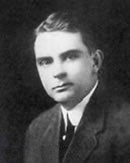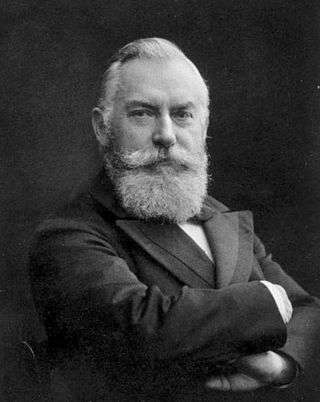
Emil Theodor Kocher was a Swiss physician and medical researcher who received the 1909 Nobel Prize in Physiology or Medicine for his work in the physiology, pathology and surgery of the thyroid. Among his many accomplishments are the introduction and promotion of aseptic surgery and scientific methods in surgery, specifically reducing the mortality of thyroidectomies below 1% in his operations.

Neurosurgery or neurological surgery, known in common parlance as brain surgery, is the medical specialty concerned with the surgical treatment of disorders which affect any portion of the nervous system including the brain, spinal cord and peripheral nervous system.
Cushing's disease is one cause of Cushing's syndrome characterised by increased secretion of adrenocorticotropic hormone (ACTH) from the anterior pituitary. This is most often as a result of a pituitary adenoma or due to excess production of hypothalamus CRH that stimulates the synthesis of cortisol by the adrenal glands. Pituitary adenomas are responsible for 80% of endogenous Cushing's syndrome, when excluding Cushing's syndrome from exogenously administered corticosteroids. The equine version of this disease is Pituitary pars intermedia dysfunction.

Immune thrombocytopenic purpura (ITP), also known as idiopathic thrombocytopenic purpura or immune thrombocytopenia, is an autoimmune primary disorder of hemostasis characterized by a low platelet count in the absence of other causes. ITP often results in an increased risk of bleeding from mucosal surfaces or the skin. Depending on which age group is affected, ITP causes two distinct clinical syndromes: an acute form observed in children and a chronic form in adults. Acute ITP often follows a viral infection and is typically self-limited, while the more chronic form does not yet have a specific identified cause. Nevertheless, the pathogenesis of ITP is similar in both syndromes involving antibodies against various platelet surface antigens such as glycoproteins.

Walter Edward Dandy was an American neurosurgeon and scientist. He is considered one of the founding fathers of neurosurgery, along with Victor Horsley (1857–1916) and Harvey Cushing (1869–1939). Dandy is credited with numerous neurosurgical discoveries and innovations, including the description of the circulation of cerebrospinal fluid in the brain, surgical treatment of hydrocephalus, the invention of air ventriculography and pneumoencephalography, the description of brain endoscopy, the establishment of the first intensive care unit, and the first clipping of an intracranial aneurysm, which marked the birth of cerebrovascular neurosurgery.

A craniopharyngioma is a rare type of brain tumor derived from pituitary gland embryonic tissue that occurs most commonly in children, but also affects adults. It may present at any age, even in the prenatal and neonatal periods, but peak incidence rates are childhood-onset at 5–14 years and adult-onset at 50–74 years. People may present with bitemporal inferior quadrantanopia leading to bitemporal hemianopsia, as the tumor may compress the optic chiasm. It has a point prevalence around two per 1,000,000. Craniopharyngiomas are distinct from Rathke's cleft tumours and intrasellar arachnoid cysts.
Nelson's syndrome is a disorder that occurs in about one in four patients who have had both adrenal glands removed to treat Cushing's disease. In patients with pre-existing adrenocorticotropic hormone (ACTH)-secreting pituitary adenomas, loss of adrenal feedback following bilateral adrenalectomy can trigger the rapid growth of the tumor, leading to visual symptoms and hyperpigmentation. The severity of the disease is dependent upon the effect of ACTH release on the skin, pituitary hormone loss from mass compression, as well as invasion into surrounding structures around the pituitary gland.

Vincenz Czerny was a German Bohemian surgeon whose main contributions were in the fields of oncological and gynecological surgery.
Hypophysectomy is the surgical removal of the hypophysis. It is most commonly performed to treat tumors, especially craniopharyngioma tumors. Sometimes it is used to treat Cushing's syndrome due to pituitary adenoma or Simmond's disease It is also applied in neurosciences to understand the functioning of hypophysis. There are various ways a hypophysectomy can be carried out. These methods include transsphenoidal hypophysectomy, open craniotomy, and stereotactic radiosurgery.

Fedor Krause was a German neurosurgeon who was native of Friedland.

Erwin Payr was an Austrian-German surgeon born in Innsbruck.
Transsphenoidal surgery is a type of surgery in which an endoscope or surgical instruments are inserted into part of the brain by going through the nose and the sphenoid bone into the sphenoidal sinus cavity. Transsphenoidal surgery is used to remove tumors of the pituitary gland..
Anton Wölfler was an Austrian surgeon born in Kopezten, a village near Kladrau, Bohemia.

Karel Maydl was an Austrian surgeon who was a native of Rokytnice nad Jizerou, Bohemia.

Paul Kaznelson (1898–1959) was a Polish-born Czech scientist credited with describing the first case of pure red cell aplasia. He is also known for his contribution to the discovery of the therapeutic role of splenectomy in idiopathic thrombocytopenic purpura.

Acromegaly is a disorder that results in excess growth of certain parts of the human body. It is caused by excess growth hormone (GH) after the growth plates have closed. The initial symptom is typically enlargement of the hands and feet. There may also be an enlargement of the forehead, jaw, and nose. Other symptoms may include joint pain, thicker skin, deepening of the voice, headaches, and problems with vision. Complications of the disease may include type 2 diabetes, sleep apnea, and high blood pressure.
Endoscopic endonasal surgery is a minimally invasive technique used mainly in neurosurgery and otolaryngology. A neurosurgeon or an otolaryngologist, using an endoscope that is entered through the nose, fixes or removes brain defects or tumors in the anterior skull base. Normally an otolaryngologist performs the initial stage of surgery through the nasal cavity and sphenoid bone; a neurosurgeon performs the rest of the surgery involving drilling into any cavities containing a neural organ such as the pituitary gland. The use of endoscope was first introduced in Transsphenoidal Pituitary Surgery by R Jankowsky, J Auque, C Simon et al. in 1992 G.

Selman Uranues is an Austrian physician and professor of surgery at the Medical University of Graz. He is known for his work in the fields of minimally invasive surgery, spleen-, gastrointestinal- and acute surgery and visceral traumatology.
Nelson M. Oyesiku is a Nigerian-American professor of neurosurgery and endocrinology. With a specialty in pituitary medicine and surgery, currently, he is the chair of the department of Neurological Surgery and Professor of Medicine (Endocrinology) at the University of North Carolina in Chapel Hill. he has been editor-in-chief of Neurosurgery, Operative Neurosurgery, and Neurosurgery Open. He was previously chair of the American Board of Neurological Surgery, among other organizations.
Gabriel Zada is Professor of Neurological Surgery at the University of Southern California. He is known for his expertise in brain tumor and pituitary tumor surgery and as an innovator in minimally invasive cranial surgery. Zada is the director of the USC Brain Tumor Center, USC Endoscopic Skull Base Surgery Program and USC Radiosurgery Center. He is also an NIH-funded principal investigator at the Zilkha Neurogenetic Institute. He specializes in endoscopic and minimally invasive neurosurgical techniques. During his career, he has published over 200 peer-reviewed articles on various neurosurgical topics, and holds numerous U.S. patents pertaining to minimally invasive neurosurgery and surgical devices.












